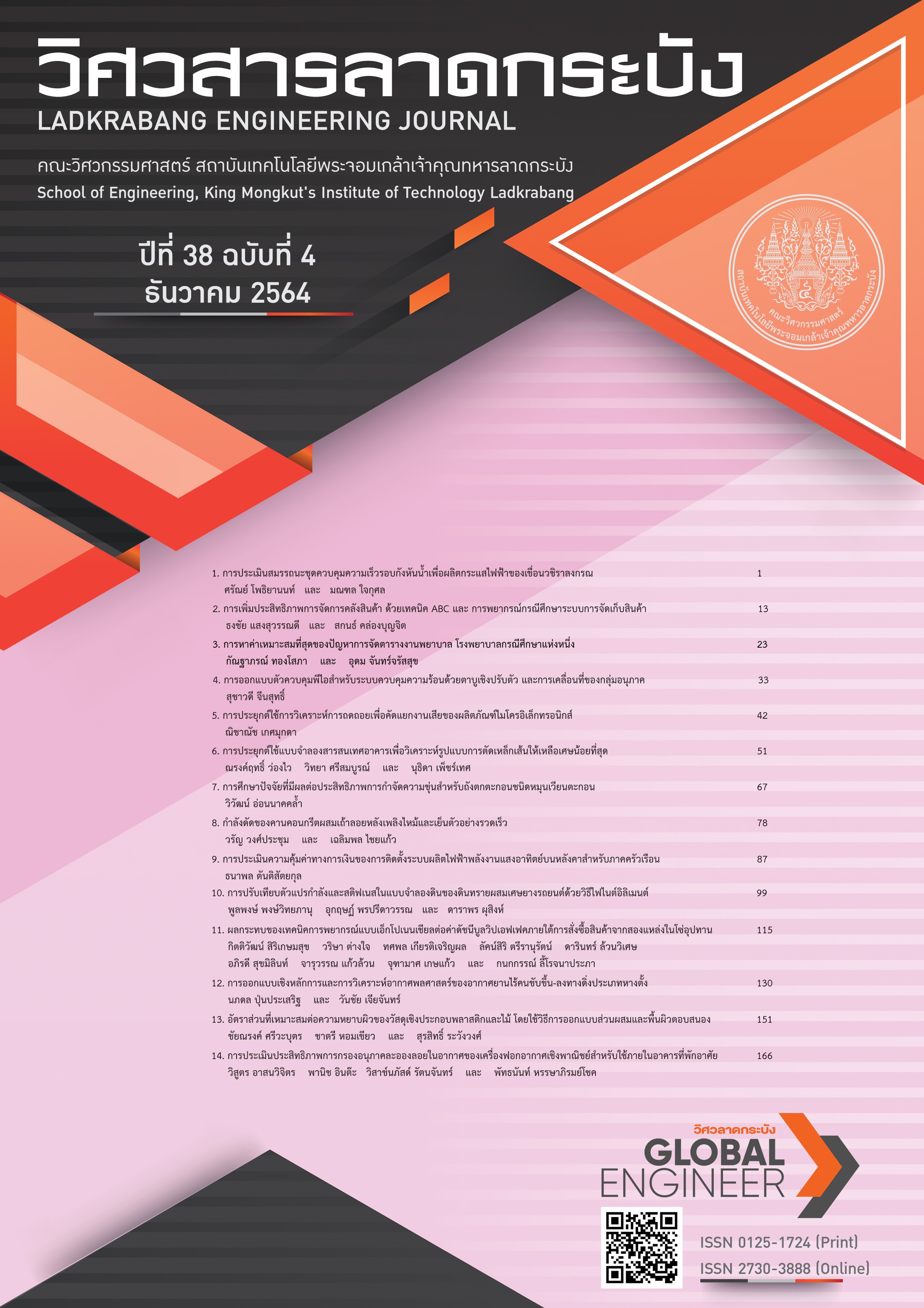Financial Feasibility Study of Installing Solar Photovoltaic Rooftop for Residential Sector
Keywords:
Solar Rooftop, Financial Feasibility, Residential SectorAbstract
This research assessed the financial feasibility of installing a solar rooftop system for households under the government's stimulus program using system sizes of 3 kWp, 5 kWp, and 10 kWp as cases study. Internal rate of return (IRR) was used as an indicator so that the results can be compared with other investment alternatives. Financial feasibility criteria was set two levels: 1) a minimum loan rate (6.3%) for homeowners having mortgage loan and 2) government bond rate (2.5%) for homeowners without mortgage loan. The results showed that the 10 kWp system was financially feasible through the second criteria, while the 3 kWp and 5 kWp systems did not meet both of the financial feasibility criteria. In addition, a sensitivity analysis and scenario analysis were performed to assess the project risks considering the variables: 1) an electricity self-consumption ratio and 2) an annual escalation rate of electricity tariff. The results suggested that the solar rooftop is more suitable for installation for self-consumption than installation for selling the electricity back to the electrical grid.
References
Department of alternative energy development and efficiency (DEDE), “Alternative Energy Development Plan 2018-2037 (AEDP 2018),” Ministry of Energy, Bangkok, Thailand, 2020. [Online]. Available:https://www.dede.go.th/download/Plan_62/20201021_TIEB_AEDP2018.pdf
T. Tantisattayakul, “An assessment of financial promotion measures for residential solar photovoltaic rooftop system in Thailand,” Thai Science and Technology Journal, vol. 23, no. 4, pp. 606–621, 2015.
T. Tantisattayakul and P. Kanchanapiya, “Financial measures for promoting residential rooftop photovoltaics under a feed-in tariff framework in Thailand,” Energy Policy, vol. 109, pp. 260–269, 2017, doi:10.1016/j.enpol.2017.06.061.
Energy Regulatory Commission (ERC). “Solar rooftop for public sector.”solar.erc.or.th.http://solar.erc.or.th/solar62/index.html. (Accessed: Mar 1, 2021).
Energy Policy and Planning Office (EPPO), “Power Development Plan 2018 revision 1 (PDP2018 revision1),” Ministry of Energy, Bangkok, Thailand 2020. [Online]. Available: http://www.eppo.go.th/images/Infromation_service/public_relations/PDP2018/PDP2018Rev1.pdf
G. Panprayun, “8 kWp Rooftop PV System and Feasibility of System Expansion,” Journal of Professional Routine to Research, vol. 4, pp. 76–86, 2017.
N. Suwanasang and S. Tongsopit, “An Assessment of the Technical and Economic Potential of Rooftop Solar Systems on Chulalongkorn University’s Buildings,” Journal of Energy Research, vol. 12, no. 2, pp. 59–74, 2015.
T. Tantisattayakul, P. Rassameethammachote, M. Auisakul, “Energy, Environmental and Economic Assessment of Solar Rooftop Systems on Buildings of Thammasat University, Rangsit Centre,” Thai Science and Technology Journal, vol. 25, no. 6, pp. 1083–1099, 2017.
P. Piriyasatta, “Using Photovoltaic System on The Faculty of Architecture’s Building Rooftop in Khon Kaen University for Energy Conservation,” Built Environment Inquiry Journal Faculty of Architecture Khon Kaen University, vol. 15, no. 1, pp. 183–200, 2016.
W. Pichitkunchorn and K. Chayakulkheeree, “Design and Economic Analysis of Solar Rooftop Electric System on the Building of Post Engineering Department,” Engineering Journal of Research and Development, vol. 29, no. 1, pp. 25–36, 2018.
K. Chaivanich, P. Ubolsook, M. Sangthong, “The Assessment in Reducing Greenhouse Gas Emission and Economical Worthiness of Solar Farm in Chulachomklao Royal Military Academy,” Science and Technology Nakhon Sawan Rajabhat University Journal, vol. 10, no. 12, 35–46, 2018.
R. Chuchart and D. Amonhaemanon, “An Assessment of Financial Worthiness for Solar Cell Rooftop The Case Study of Sawn Timber Hevea Wood Factory in Trang Province,” NIDA Business Journal, vol. 26, pp. 6–35, 2020.
K. Sripodok, “The Value of Investment on Renewable Energy: A Case Study of Power Generation by Solar Energy Roof System Projected by HOMEPRO, Mega Home and Market Village,” Social Science Journal of Prachchuen Research Network, vol. 2, no. 1, pp. 52–69, 2020.
T. Potisat, S. Tongsopit, A. Aksornkij and S. Moungchareon, “To buy the system or to buy the service:the emergence of a solar service model in Thailand,” Renewable Energy Focus, vol. 21, pp. 1–10, 2017, doi:10.1016/j.ref.2017.06.002.
S. Yoonmak, T. Patcharoen and A, Ngaopitakkul, “Performance and Economic E,valuation of Solar Rooftop System in Different Regions of Thailand,” Sustainability, vol. 11, no. 23, pp. 6647, 2019, doi: 10.3390/su11236647.
M. Woodhouse, R. J. Albertus, D. Feldman, R. Fu, K. Horowitz, D. Chung, D. Jordan and S. Kurtz, “On the path to SunShot: The role of advancements in solar photovoltaic efficiency, reliability, and costs,” National Renewable Energy Laboratory, Washington, DC, USA, pp. 36, 2016, doi: 10.2172/1253983.
A. Limmanee, N. Udomdachanut, S. Songtrai, A. Kaewniyompanit, Y. Sato, M. Nakaishi, S. Kittisontirak, K. Sriprapha and Y. Sakamoto, “Field performance and degradation rates of different types of photovoltaic modules: A case study in Thailand,” Renewable Energy, vol. 89, pp. 12–17, 2016, doi:10.1016/j.renene.2015.11.088.
D.C. Jordan, R.M. Smith, C.R. Osterwald, E. Gelak and S.R. Kurtz, “Outdoor PV Degradation Comparison”, presented at the 35th IEEE Photovoltaic Specialists Conference, Honnolulu, HI , USA, June 20–25, 2010, 2694–2697, doi: 10.1109/PVSC.2010.5616925
D. C. Jordan and S. R. Kurtz, “Photovoltaic Degradation Rates: An Analytical Review,” Photovoltaics, vol 21, no. 1, 12–29, 2013, doi: 10.1002/pip.1182
Macroeconomic indicators of Thailand, Bank of Thailand, Mar 1, 2021. [Online]. Available:https://www.bot.or.th/App/BTWS_STAT/statistics/ReportPage.aspx?reportID=409&language=th
Loan interest rate, Bank of Thailand, Mar 1, 2021. [Online]. Available: https://www.bot.or.th/thai/statistics/financialmarkets/interestrate/_layouts/application/interest_rate/in_rate.aspx.
Downloads
Published
How to Cite
Issue
Section
License
Copyright (c) 2021 Faculty of Engineering, King Mongkut’s Institute of Technology Ladkrabang

This work is licensed under a Creative Commons Attribution-NonCommercial-NoDerivatives 4.0 International License.
The published articles are copyrighted by the School of Engineering, King Mongkut's Institute of Technology Ladkrabang.
The statements contained in each article in this academic journal are the personal opinions of each author and are not related to King Mongkut's Institute of Technology Ladkrabang and other faculty members in the institute.
Responsibility for all elements of each article belongs to each author; If there are any mistakes, each author is solely responsible for his own articles.






